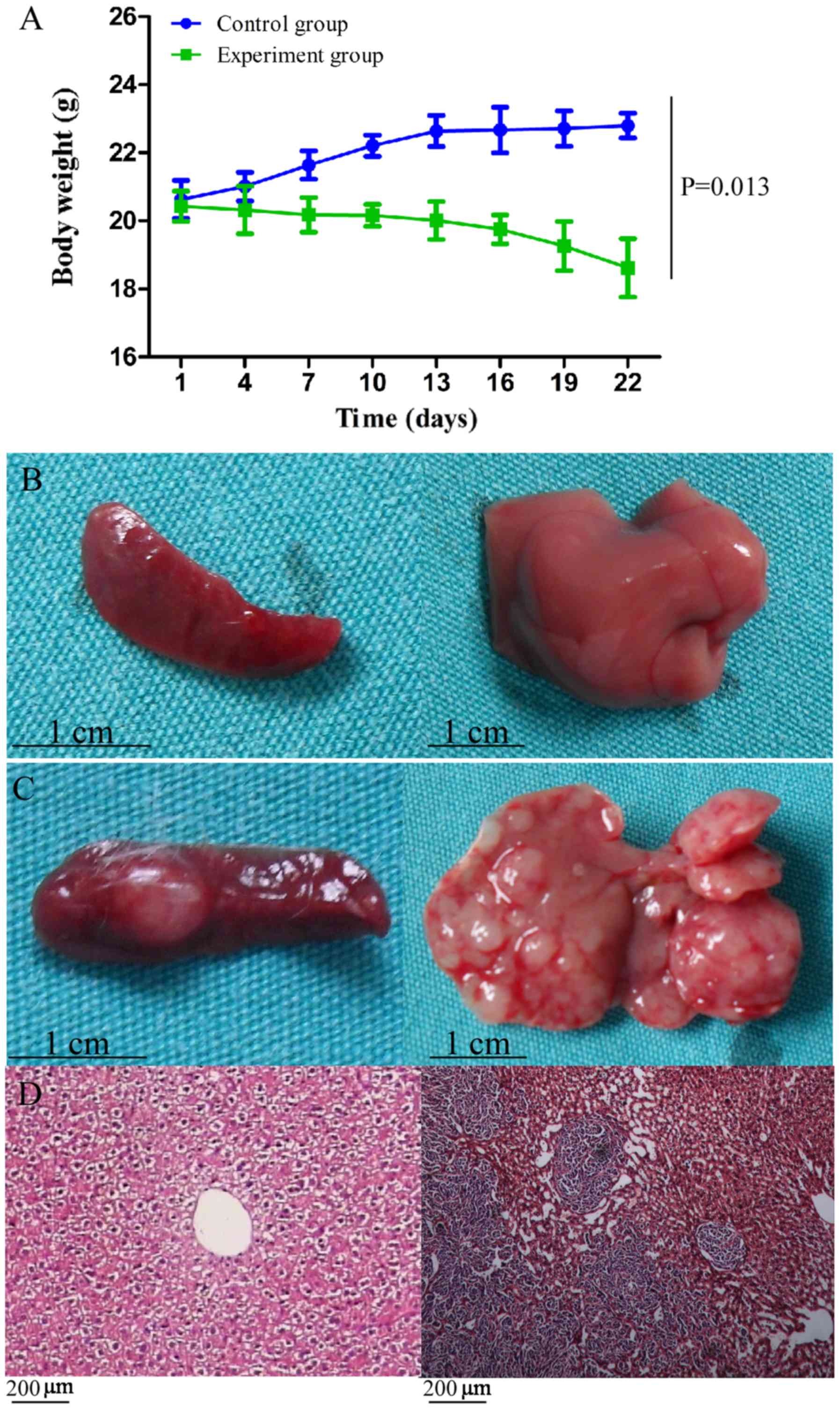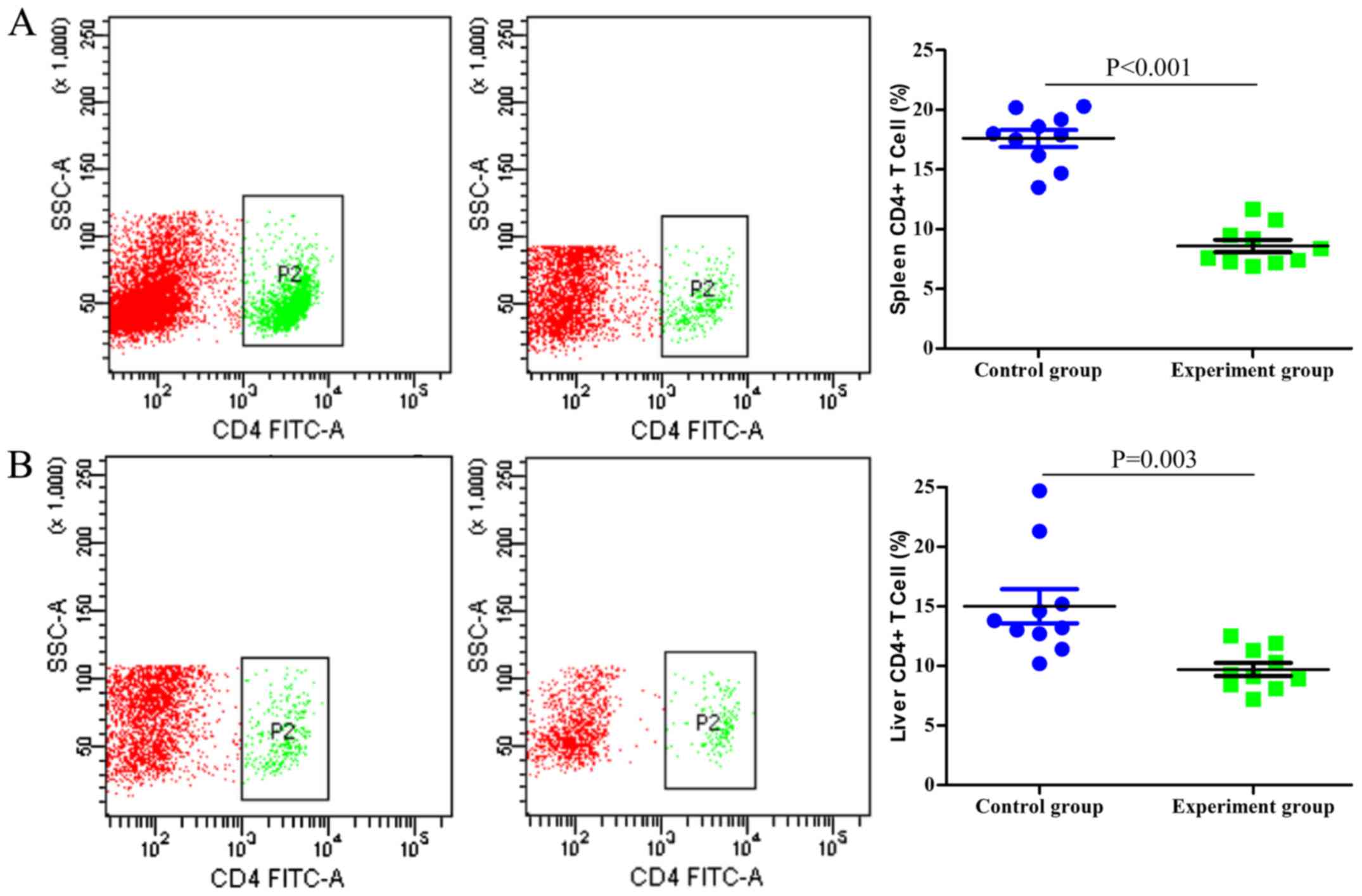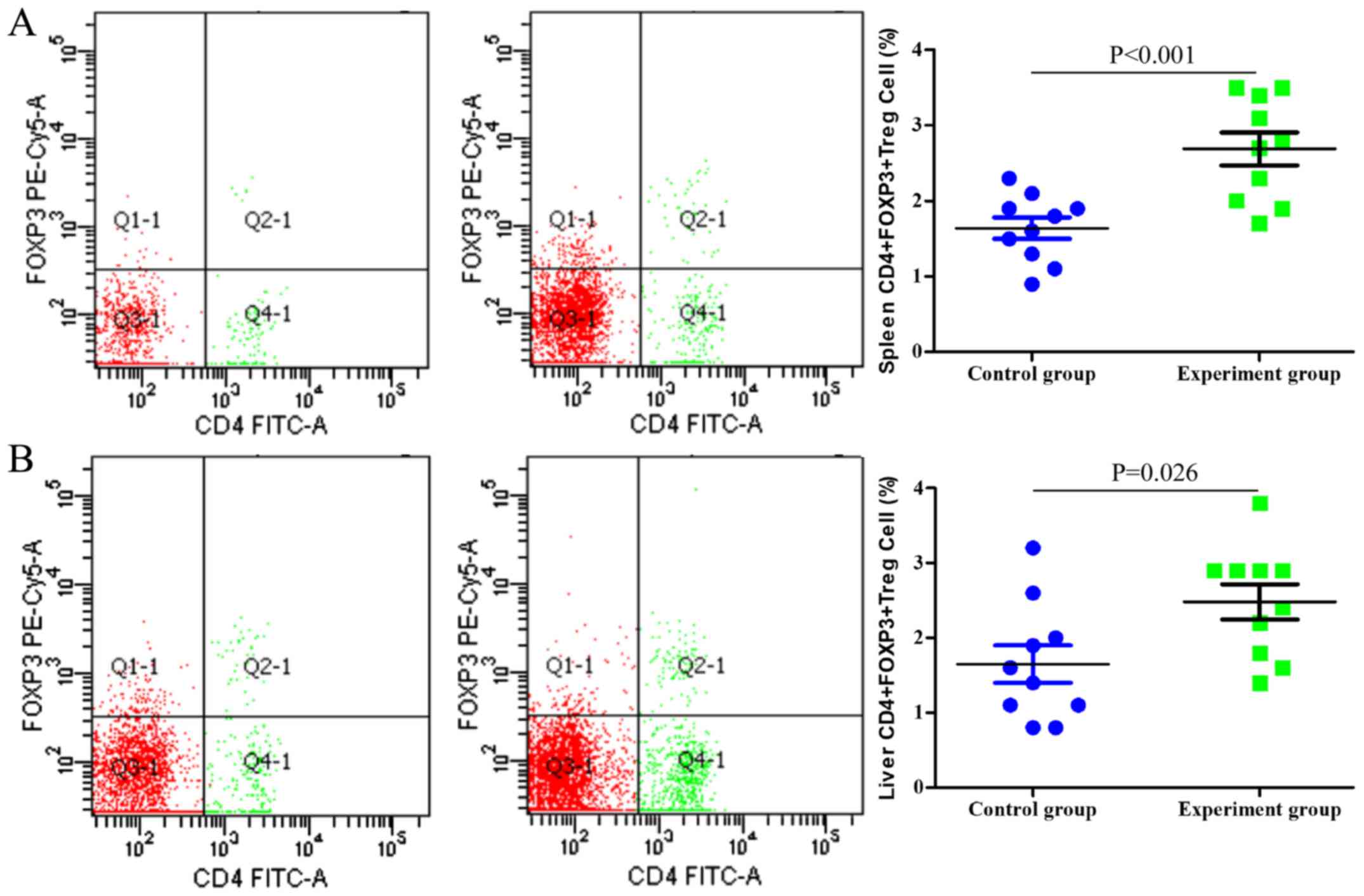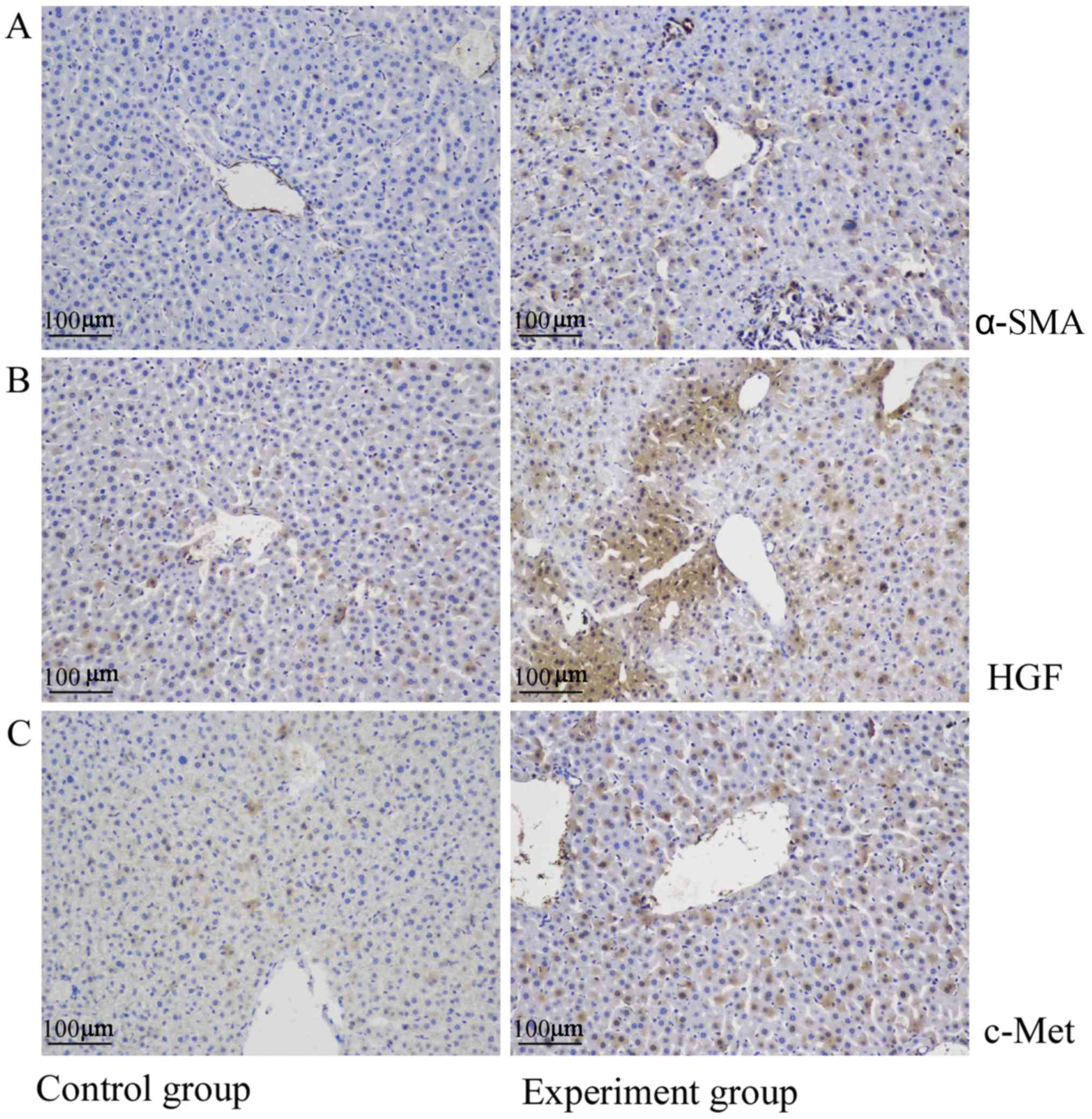|
1
|
Torre LA, Bray F, Siegel RL, Ferlay J,
Lortet-Tieulent J and Jemal A: Global cancer statistics, 2012. CA
Cancer J Clin. 65:87–108. 2015. View Article : Google Scholar : PubMed/NCBI
|
|
2
|
Bengmark S and Hafstrom L: The natural
history of primary and secondary malignant tumors of the liver. I.
The prognosis for patients with hepatic metastases from colonic and
rectal carcinoma by laparotomy. Cancer Am Cancer Soc. 23:198–202.
1969.
|
|
3
|
Manfredi S, Lepage C, Hatem C, Coatmeur O,
Faivre J and Bouvier AM: Epidemiology and management of liver
metastases from colorectal cancer. Ann Surg. 244:254–259. 2006.
View Article : Google Scholar : PubMed/NCBI
|
|
4
|
Konopke R, Roth J, Volk A, Pistorius S,
Folprecht G, Zöphel K, Schuetze C, Laniado M, Saeger HD and
Kersting S: Colorectal liver metastases: An update on palliative
treatment options. J Gastrointestin Liver Dis. 21:83–91.
2012.PubMed/NCBI
|
|
5
|
Lykoudis PM, O'Reilly D, Nastos K and
Fusai G: Systematic review of surgical management of synchronous
colorectal liver metastases. Br J Surg. 101:605–612. 2014.
View Article : Google Scholar : PubMed/NCBI
|
|
6
|
Robinson MW, Harmon C and O'Farrelly C:
Liver immunology and its role in inflammation and homeostasis. Cell
Mol Immunol. 13:267–276. 2016. View Article : Google Scholar : PubMed/NCBI
|
|
7
|
Nishikawa H and Sakaguchi S: Regulatory T
cells in cancer immunotherapy. Curr Opin Immunol. 27:1–7. 2014.
View Article : Google Scholar : PubMed/NCBI
|
|
8
|
Huang X, Zou Y, Lian L, Wu X, He X, He X,
Wu X, Huang Y and Lan P: Changes of T cells and cytokines TGF-β1
and IL-10 in mice during liver metastasis of colon carcinoma:
Implications for liver anti-tumor immunity. J Gastrointest Surg.
17:1283–1291. 2013. View Article : Google Scholar : PubMed/NCBI
|
|
9
|
Bárcena C, Stefanovic M, Tutusaus A,
Martinez-Nieto GA, Martinez L, García-Ruiz C, de Mingo A,
Caballeria J, Fernandez-Checa JC, Marí M and Morales A: Angiogenin
secretion from hepatoma cells activates hepatic stellate cells to
amplify a self-sustained cycle promoting liver cancer. Sci Rep.
5:79162015. View Article : Google Scholar : PubMed/NCBI
|
|
10
|
Gupta G, Khadem F and Uzonna JE: Role of
hepatic stellate cell (HSC)-derived cytokines in hepatic
inflammation and immunity. Cytokine. 124:1545422019. View Article : Google Scholar : PubMed/NCBI
|
|
11
|
Lu DH, Guo XY, Qin SY, Luo W, Huang XL,
Chen M, Wang JX, Ma SJ, Yang XW and Jiang HX: Interleukin-22
ameliorates liver fibrogenesis by attenuating hepatic stellate cell
activation and downregulating the levels of inflammatory cytokines.
World J Gastroenterol. 21:1531–1545. 2015. View Article : Google Scholar : PubMed/NCBI
|
|
12
|
Weiskirchen R and Tacke F: Cellular and
molecular functions of hepatic stellate cells in inflammatory
responses and liver immunology. Hepatobiliary Surg Nutr. 3:344–363.
2014.PubMed/NCBI
|
|
13
|
Patel MB, Pothula SP, Xu Z, Lee AK,
Goldstein D, Pirola RC, Apte MV and Wilson JS: The role of the
hepatocyte growth factor/c-MET pathway in pancreatic stellate
cell-endothelial cell interactions: Antiangiogenic implications in
pancreatic cancer. Carcinogenesis. 35:1891–1900. 2014. View Article : Google Scholar : PubMed/NCBI
|
|
14
|
Cai W, Rook SL, Jiang ZY, Takahara N and
Aiello LP: Mechanisms of hepatocyte growth factor-induced retinal
endothelial cell migration and growth. Invest Ophthalmol Vis Sci.
41:1885–1893. 2000.PubMed/NCBI
|
|
15
|
Pothula SP, Xu Z, Goldstein D, Biankin AV,
Pirola RC, Wilson JS and Apte MV: Hepatocyte growth factor
inhibition: A novel therapeutic approach in pancreatic cancer. Br J
Cancer. 114:269–280. 2016. View Article : Google Scholar : PubMed/NCBI
|
|
16
|
Parr C and Jiang WG: Expression of
hepatocyte growth factor/scatter factor, its activator, inhibitors
and the c-Met receptor in human cancer cells. Int J Oncol.
19:857–863. 2001.PubMed/NCBI
|
|
17
|
Syed Khaja A, Toor SM, El SH, Ali BR and
Elkord E: Intratumoral FoxP3+Helios+
regulatory T cells upregulating immunosuppressive molecules are
expanded in human colorectal cancer. Front Immunol. 8:6192017.
View Article : Google Scholar : PubMed/NCBI
|
|
18
|
Liu HY, Huang ZL, Yang GH, Lu WQ and Yu
NR: Inhibitory effect of modified citrus pectin on liver metastases
in a mouse colon cancer model. World J Gastroenterol. 14:7386–7391.
2008. View Article : Google Scholar : PubMed/NCBI
|
|
19
|
Takeuchi Y and Nishikawa H: Roles of
regulatory T cells in cancer immunity. Int Immunol. 28:401–409.
2016. View Article : Google Scholar : PubMed/NCBI
|
|
20
|
Fontenot JD, Gavin MA and Rudensky AY:
Foxp3 programs the development and function of
CD4+CD25+ regulatory T cells. Nat Immunol.
4:330–336. 2003. View
Article : Google Scholar : PubMed/NCBI
|
|
21
|
Shimizu J, Yamazaki S and Sakaguchi S:
Induction of tumor immunity by removing
CD25+CD4+ T cells: A common basis between
tumor immunity and autoimmunity. J Immunol. 163:5211–5218.
1999.PubMed/NCBI
|
|
22
|
Onizuka S, Tawara I, Shimizu J, Sakaguchi
S, Fujita T and Nakayama E: Tumor rejection by in vivo
administration of anti-CD25 (interleukin-2 receptor alpha)
monoclonal antibody. Cancer Res. 59:3128–3133. 1999.PubMed/NCBI
|
|
23
|
Almeida AR, Ciernik IF, Sallusto F and
Lanzavecchia A: CD4+ CD25+ Treg regulate the
contribution of CD8+ T-cell subsets in repopulation of
the lymphopenic environment. Eur J Immunol. 40:3478–3488. 2010.
View Article : Google Scholar : PubMed/NCBI
|
|
24
|
Zanin-Zhorov A, Ding Y, Kumari S, Attur M,
Hippen KL, Brown M, Blazar BR, Abramson SB, Lafaille JJ and Dustin
ML: Protein kinase C-theta mediates negative feedback on regulatory
T cell function. Science. 328:372–376. 2010. View Article : Google Scholar : PubMed/NCBI
|
|
25
|
Arlt F and Stein U: Colon cancer
metastasis: MACC1 and Met as metastatic pacemakers. Int J Biochem
Cell Biol. 41:2356–2359. 2009. View Article : Google Scholar : PubMed/NCBI
|
|
26
|
Bradley CA, Salto-Tellez M, Laurent-Puig
P, Bardelli A, Rolfo C, Tabernero J, Khawaja HA, Lawler M, Johnston
PG and Van Schaeybroeck S; MErCuRIC consortium, : Targeting c-MET
in gastrointestinal tumours: Rationale, opportunities and
challenges. Nat Rev Clin Oncol. 14:562–576. 2017. View Article : Google Scholar : PubMed/NCBI
|
|
27
|
Shojaei F, Simmons BH, Lee JH, Lappin PB
and Christensen JG: HGF/c-Met pathway is one of the mediators of
sunitinib-induced tumor cell type-dependent metastasis. Cancer
Lett. 320:48–55. 2012. View Article : Google Scholar : PubMed/NCBI
|
|
28
|
Osada S, Matsui S, Komori S, Yamada J,
Sanada Y, Ihawa A, Tanaka Y, Tokuyama Y, Okumura N, Nonaka K, et
al: Effect of hepatocyte growth factor on progression of liver
metastasis in colorectal cancer. Hepatogastroenterology. 57:76–80.
2010.PubMed/NCBI
|
|
29
|
Olguín JE, Medina-Andrade I, Molina E,
Vázquez A, Pacheco-Fernández T, Saavedra R, Pérez-Plasencia C,
Chirino YI, Vaca-Paniagua F, Arias-Romero LE, et al: Early and
partial reduction in CD4+Foxp3+ regulatory T
cells during Colitis-associated colon cancer induces
CD4+ and CD8+ T cell activation inhibiting
tumorigenesis. J Cancer. 9:239–249. 2018. View Article : Google Scholar : PubMed/NCBI
|


















